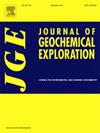Multistage genesis of the carbonate-hosted Tuokesai Pb–Zn deposit, West Tianshan, NW China: Synsedimentary strata-bound mineralization and hydrothermal remobilization
IF 3.3
2区 地球科学
Q1 GEOCHEMISTRY & GEOPHYSICS
引用次数: 0
Abstract
The Tuokesai Pb–Zn deposit is located in the eastern section of the West Tianshan Orogen within Precambrian carbonate rocks. However, the genesis of the ore, including sedimentary exhalative and sedimentary-metamorphic types, remains controversial owing to varying interpretations of strata-bound and vein-type mineralization. In this study, we aimed to construct an innovative genesis model, focusing on two mineralization types, by analyzing fluid evolution, material sources, and trace element distributions. Three mineralization stages were identified, each with specific pyrite generation. Stage I pyrite–sphalerite–galena bands (Py-1 and Py-2) represent strata-bound mineralization. Stage II sphalerite–pyrite–quartz veins (Py-3) and Stage III pyrite–quartz–calcite veins (Py-4) represent vein-type mineralization. Fluid inclusion microthermometric and H–O isotopic analyses revealed that Stage I fluids are characterized by low temperatures (132–171 °C) and moderate salinities (11.8–17.3 wt% NaCl eqv.), and are derived from modified seawater. Conversely, fluids in Stages II–III are associated with moderate temperatures (165–267 °C) and variable salinities (2.1–35.3 wt% NaCl eqv.), being derived from a mixture of magmatic and meteoric water. The in situ S isotopic composition suggests that Py-1 and Py-2 (δ34S = 9.46–12.20 ‰) originated from the thermochemical reduction of marine sulfate, whereas Py-3 and Py-4 (δ34S = 0.85–3.85 ‰) originated from magmatic components. LA–ICP–MS analysis of trace elements in pyrite, combined with machine learning classification methods, indicated that Py-1 and Py-2 have a synsedimentary origin whereas Py-3 and Py-4 have a magmatic-hydrothermal origin. Overall, our findings support a novel multistage genesis model for the Tuokesai Pb–Zn deposit, suggesting that Neoproterozoic syngenetic strata-bound mineralization was overprinted by Late Paleozoic vein-type hydrothermal remobilization. This model highlights the importance of incorporating diverse geological events into our understanding of the ore-forming process to facilitate the exploration of carbonate-hosted Pb–Zn deposits within the West Tianshan Orogen.
西天山托克赛碳酸盐岩铅锌矿床多期成因:同沉积地层成矿作用与热液再活化作用
托克赛铅锌矿床位于西天山造山带东段前寒武纪碳酸盐岩中。然而,矿石的成因,包括沉积喷发型和沉积变质型,由于对地层束缚型和脉状矿化的不同解释,仍然存在争议。通过对流体演化、物质来源和微量元素分布的分析,构建了以两种成矿类型为中心的创新成因模型。确定了三个成矿阶段,每个阶段都有特定的黄铁矿生成。第I阶段黄铁矿-闪锌矿-方铅矿带(Py-1和Py-2)代表层控矿化。第二阶段闪锌矿—黄铁矿—石英脉(Py-3)和第三阶段黄铁矿—石英—方解石脉(Py-4)为脉状成矿。流体包裹体显微测温和氢氧同位素分析表明,ⅰ期流体具有低温(132 ~ 171℃)和中等盐度(11.8 ~ 17.3 wt% NaCl eqv)的特征,来源于改性海水。相反,II-III阶段的流体温度适中(165-267°C),盐度变化(2.1 - 35.3% NaCl当量),来自岩浆和大气水的混合物。原位S同位素组成表明,Py-1和Py-2 (δ34S = 9.46 ~ 12.20‰)来源于海相硫酸盐热化学还原作用,Py-3和Py-4 (δ34S = 0.85 ~ 3.85‰)来源于岩浆组分。结合机器学习分类方法,对黄铁矿中微量元素进行LA-ICP-MS分析,发现pyy -1和pyy -2为同沉积成因,而pyy -3和pyy -4为岩浆-热液成因。综上所述,托克赛铅锌矿床的形成过程支持了一种新的多期成矿模式,表明新元古代同生地层成矿作用叠加了晚古生代脉状热液再活化作用。该模型强调了将不同地质事件纳入我们对成矿过程的理解的重要性,以促进在西天山造山带内碳酸盐岩含铅锌矿床的勘探。
本文章由计算机程序翻译,如有差异,请以英文原文为准。
求助全文
约1分钟内获得全文
求助全文
来源期刊

Journal of Geochemical Exploration
地学-地球化学与地球物理
CiteScore
7.40
自引率
7.70%
发文量
148
审稿时长
8.1 months
期刊介绍:
Journal of Geochemical Exploration is mostly dedicated to publication of original studies in exploration and environmental geochemistry and related topics.
Contributions considered of prevalent interest for the journal include researches based on the application of innovative methods to:
define the genesis and the evolution of mineral deposits including transfer of elements in large-scale mineralized areas.
analyze complex systems at the boundaries between bio-geochemistry, metal transport and mineral accumulation.
evaluate effects of historical mining activities on the surface environment.
trace pollutant sources and define their fate and transport models in the near-surface and surface environments involving solid, fluid and aerial matrices.
assess and quantify natural and technogenic radioactivity in the environment.
determine geochemical anomalies and set baseline reference values using compositional data analysis, multivariate statistics and geo-spatial analysis.
assess the impacts of anthropogenic contamination on ecosystems and human health at local and regional scale to prioritize and classify risks through deterministic and stochastic approaches.
Papers dedicated to the presentation of newly developed methods in analytical geochemistry to be applied in the field or in laboratory are also within the topics of interest for the journal.
 求助内容:
求助内容: 应助结果提醒方式:
应助结果提醒方式:


